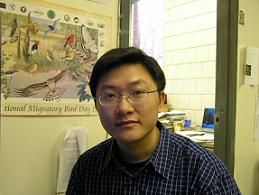Baseline Study of Aquatic Macroinvertebrates in the Red River of the North - Main Stem

Wei Zheng is interested in freshwater ecology, community ecology (with emphasis on macroinvertebrates), large rivers and streams. Wei earned his Bachelor’s degree (1999) in Forest Conservation at FAFU, China, with emphasis on Entomology and Pathology, and a Master’s degree (2003) from the same university with research on Nematology and Nematode Ecology. Wei is currently pursuing a Ph.D degree in the ECS program under the direction of Dr. Malcolm Butler, studying aquatic invertebrates in the Red River of the North.
Email: wei.zheng@ndsu.edu
Phone: 701-793-4311
Fellow: Wei Zheng Program of Environmental and Conservation Science, NDSU
Advisor: Malcolm Butler Department of Biological Science, NDSU
Matching Support: Environmental and Conservation Sciences Program; NDSU Graduate School; USBR - Dakotas Area Office (support pending)
Degree Progress: Ph.D expected in Dec.2008
Baseline Study of Aquatic Macroinvertebrates in the Red River of the North - Main Stem
Project Objectives:
Our study is a survey of macroinvertebrate communities in major habitats of the main-stem Red River. We will assess the overall diversity of the invertebrate fauna, determine what types of animals predominate in diverse habitats within this river. We seek to identify ecologically significant taxa in terms of abundance or functional importance in the river, and to determine candidate indicators for future biomonitoring. We will also assess a range of sampling techniques for monitoring this fauna. This information will be used by the Aquatic Ecosystem Committee of the International Red River Board and its collaborators to develop a broader research proposal for comprehensive biological monitoring of the Red River main stem by multiple jurisdictions.
Progress to Date:
Drift net sampling was conducted from 27 May to 4 November 2006. Nets were deployed from bridges over the main-stem Red River at three different locations: within Fargo-Moorhead (FM), 26 river-km north of FM, and 38 river-km south of FM. Triplicate nets were deployed overnight at two week intervals. We are now in the process of identifying and quantifying the macroinvertebrates from these drift samples. Infaunal benthos was sampled with a Ponar grab at five cross-channel transects at different sites along the river. We also deployed artificial substrates (standard Hester-Dendy samplers plus a custom-made ash log substrate design) for 5 weeks beginning on 1 Sept 2006.
Preliminary results from the drift nets indicate that drift densities reached a maximum during summer, peaking in late August. Community composition differed between sampling sites and over time. Dominant taxa over the season included chironomid larvae, elmid beetle larvae, adults of several aquatic beetle families, as well as terrestrial Coleoptera. Chironomidae displayed the highest drift rates from August to early September, when other taxa were relatively sparse in the drift. The burrowing mayfly Ephoron (Polymitarcidae) had a notable emergence in mid-summer. Several drifting taxa (Chironomidae) were significantly negatively related to discharge, but not to other hydrological parameters. Seasonal variability in drift likely results from the life histories of individual species, as well as fluctuations in discharge. Terrestrial insects made a substantial contribution to invertebrate drift in this river reach.
These drift net samples will provide a unique inventory of the invertebrate fauna of the Red River in the FM area. Although these data will be biased toward insects (due to their emergence behavior) and exclude non-drifting taxa such as unionid mussels, we are impressed at the diversity of the fauna represented – including large numbers of small gastropods and a major contribution by terrestrial arthropods. These data show us which species, at a minimum, live in the river, and will permit a general ranking of each taxon’s abundance and potential ecological significance. The drift data also point to important issues for continued investigation. Our transect samples of the river channel produced very low densities of only a few species, and the microhabitats occupied by a majority of the fauna remain undiscovered. For example, the mayfly Ephoron album is conspicuous in the drift during its emergence in late July-mid August, but we have yet to collect a single larva from a benthic habitat. The majority of the Chironomidae and other insect taxa probably live on flotsam and organic debris associated with woody snags distributed sporadically along the river. Work in 2007 will focus on determining and quantifying the fauna associated with such habitats, and in seeking unique microhabitats that support other ecologically significant macroinvertebrates.
Significance:
From the data to be collected in this two-year study, we expect to characterize the overall diversity of invertebrate organisms that occur in this portion of the main stem Red River. Currently, no such synoptic, taxonomic list of the river’s invertebrate fauna exists. In addition, we will be able to characterize the contribution of different habitat types to overall invertebrate abundance and diversity. Our standardized and quantitative methods, along with stratification of discrete riverine habitats, will allow us to express the quantitative importance of all components of the fauna – including taxa of potential ecological significance that may have been neglected in previous surveys. By employing a range of sampling techniques, we will be able to judge the efficacy of different sampling methods for characterizing taxa that may be significant indicators of the river’s function and condition.
Presentations (Chronological Order):
“Compare macroinvertebrate community between fish and fishless wetlands”. NDSU department of biological science Zoology 496/696: Wildlife and fishery management techniques Fargo, ND May 5, 2005
“A survey of macroinvertebrates on the Red River of the North”. NDSU Department of Biological Sciences Zoology 470/670: Limnology, Fargo, ND Dec 12, 2005
“A baseline study of aquatic macroinvertebrates on the Red River of the North” NDSU ECS seminar Fargo, ND May 25, 2006
“Macroinvertebrate drift in the Main stem Red River of the North” International Water Institute Grand Forks, ND March 17, 2007

Melcolm Butler
Biological Sciences
Office: Research 2, Room 214B
Phone: 701-231-7398
Email: malcolm.butler@ndsu.edu


